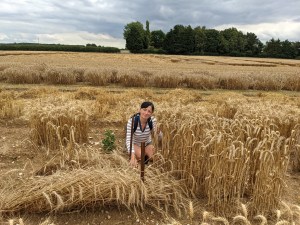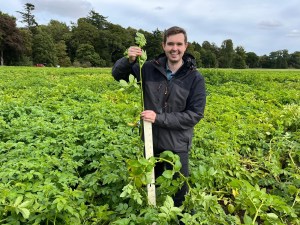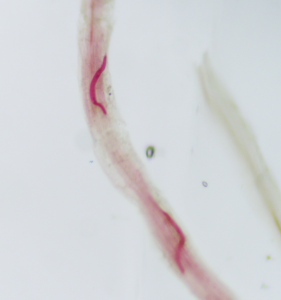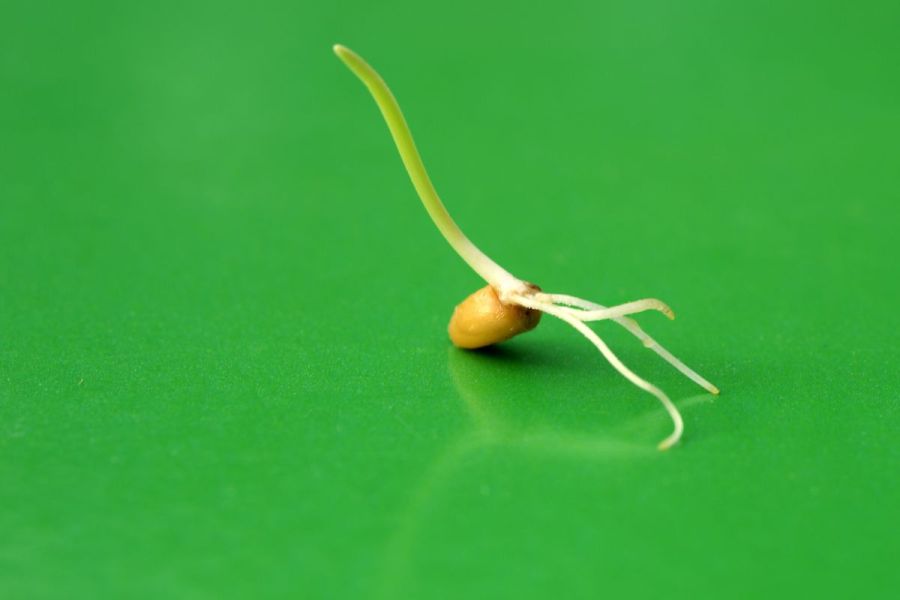The connection between plants and the rhizosphere is an area of huge interest to scientists. CPM learns how understanding these interactions may lead to the introduction of beneficial root traits on crop plants.
“Biological nitrification inhibitors released through plant exudates can tune microbial nitrogen cycling to optimize plant uptake and use.”
By Heather Briggs
Beneficial root traits introduced in wheat crops, such as biological nitrification inhibition, can improve nitrogen use efficiency (NUE), help support sustainable production and address current environmental and economic challenges, said Dr María Hernández-Soriano of the John Innes Centre.
Speaking at the ‘The nature-based and engineered biology solutions to climate mitigation’ conference organised by the Association of Applied Biologists, she explained that root traits are important drivers of ecosystem processes.
Her work has been looking beyond the architectural traits of wheat to link them to their impact in soil, exploring their effects on crop NUE, soil aggregation, and also water retention capacity.

Physiological root traits can adjust the role of roots in nutrient uptake, soil respiration and the release of root exudates to modulate soil microbiome functions, explained María Hernández-Soriano.
The WISH-ROOTS project (Wheat Improving Soil Health through Root Traits) started in 2022 with a pilot UK field trial exploring the impact of different wheat cultivars on soil health. The same field trial will be run simultaneously in six countries during 2023 and 2024.
“Physiological root traits can adjust the role of roots in nutrient uptake, soil respiration and the release of root exudates to modulate soil microbiome functions,” explained María. “This can lead us to a better understanding of the impact of root traits on biotic and abiotic processes in soil.”
Her team are screening for morphological and architectural traits, including root diameter, length, depth, lateral roots, growth angle, and exploring how they can support physical markers of soil health such as aggregation, porosity and water retention capacity.
They’ve been conducting field trials comparing wheat cultivars from the Watkins core collection of bread wheat landraces and elite modern varieties, UK spring wheat Paragon and KWS Cochise, to identify the differences in the rhizosphere.
“We found several cultivars within the ancestral groups were more efficient at controlling nitrification (transformation of ammonia into nitrate by specialized microbial communities), while this capability was reduced or lost in in modern wheat varieties.”
Biological nitrogen inhibiting (BNI) compounds target nitrifying communities in the soil, reducing their abundance when fertiliser is applied. This can decrease the transformation rate of ammonium applied as fertiliser by slowing down oxidation to nitrate and nitrous oxide, therefore providing the plant with more time to uptake both ammonium and nitrate. This directly results in a more efficient use of N while reducing environmental losses, she explained.
“This ability is important because it shows that biological nitrification inhibitors released through plant exudates can tune microbial nitrogen cycling to optimize plant uptake and use.”
Throughout María’s research with these cultivars, genetic loci in the wheat genome linked to BNI have been recently identified, which will provide the knowledge to introduce this trait in modern cultivars. In addition, her research has been assessing the ability of wheat roots to control N-cycling under different N-fertiliser regimes.
Two wheats varieties, low BNI cultivar Paragon, and high BNI cultivar Persia were compared using different regimes of nitrogen fertiliser applications. These were no applied fertiliser, one and two applications of 48kgN/ha. Samples were collected at tillering, at the emergence of the seed head (coinciding with the fertiliser application events), and after harvest they were examined for root architecture, screened for rhizosphere nitrifying communities and nitrogen transformation rate in soil.
Significant shifts in the most predominant bacterial communities took place at heading and after harvest, said María. “We observed a significant reduction in the abundance of relevant nitrifying communities in the rhizosphere of the high BNI cultivar when fertiliser was applied, particularly at heading.”
Nitrifying communities are predominant in the rhizosphere of modern cultivars at those times, which would result in higher losses of nitrogen to the environment, she added.
“Increasing nitrogen doses promoted greater abundance of Nitrospherales in the rhizosphere of the elite wheat cultivar Paragon, which were significantly lower in the Watkins landrace. It’s likely that as the plant is growing, it’s controlling the microbiome and associated functions through exudates, releasing BNI with the exudates when it has more need for N.”
María found no significant differences in root crowns but both cultivars showed significant changes in root length, depth and the number of root tips when nitrogen fertiliser dosage increased. “This shows that the fertiliser application conditions the root architecture and that has important implications for soil structure.
“These were consistent with the contrasting BNI capacity of the wheat cultivars and indicate that some historic wheat cultivars could contribute to a more sustainable strategy to optimise N-fertilisation in wheat crop systems.”
Pathogen host interactions

Dr James Price and his team are trying to identify specific traits that can be utilised in new varieties to increase their tolerance to PCN.
Understanding pathogen-host interactions may help prepare for a world without nematicides. Recent research on potato cyst nematodes (PCN) undertaken by the James Hutton Institute has been both near market and more distant, but always with the aim of helping growers address the challenges posed by the pest, says molecular plant pathologist and nematologist Dr James Price.
More varieties with tolerance and resistance are now becoming available to growers, thanks in part to work by James and the team to help speed up the breeding process.
“One of the needs of the industry is the ability to develop varieties more quickly for the market, and while molecular markers are very helpful, they’re not always available,” he said.
As part of this work, he’s seeking to understand what makes a variety tolerant to PCN and they have been studying the root structure and growth habits of a range of commercial potato varieties.
“There is broad evidence that tolerance to PCN and determinacy of the foliage growth are correlated,” he said. “However, it’s certainly more complex than this and we’re trying to identify specific traits that can be utilised in new varieties to increase their tolerance.”
Work is also building better understanding of host-pathogen interactions and recent research has identified a surface coat-associated protein which helps the pest bypass plant defences during infection, he revealed at the Advances in Nematology conference organised by the Association of Applied Biology.
“PCN secrete a diverse range of proteins through their hypodermis which effectively provide a coating that make it easier for them to adapt to their local environment and can make it more difficult for the host to defend itself.
“As the nematode passes through the roots, it causes the release of cell wall breakdown products that are detected by the plant, which then mounts a defence response,” he said.
The presence of the protein, a galectin, in this secretion is key because it allows the coating to soak up the carbohydrates produced by the damaged cell walls, so the plant’s defence response can be suppressed.
“This increases the chance of juvenile survival allowing the nematode to invade and thrive within the host.”
First eggshell protein
James and his team have also had a breakthrough in understanding how to stimulate or inhibit PCN hatching, thanks to the identification of a novel annexin-like protein that forms an integral part of the Globodera rostochiensis eggshell.
It’s likely that the eggshell annexin is located at the lipid membranes that form the eggshell permeability barrier.

Juvenile PCN inside a potato root stained with acid fuchsin. Photo: James Price
He explained that an unhatched juvenile PCN is normally well adapted for long-term survival in adverse environments. The eggshell, which comprises numerous lipid layers as well as a thick chitinous layer, is selectively permeable and provides protection from biotic and abiotic stresses. While it’s in the eggshell, the unhatched juvenile is partially dehydrated and surrounded by a fluid that protects the dormant nematode from extremes of temperature.
“PCN hatching takes place in response to chemical cues from suitable host plants, and we now believe this is driven by the calcium-dependent annexin-like protein, specific to the PCN eggshell.
“Reducing the level of this protein reduces the ability of the nematode to control permeability of the eggshell because the lipid binding properties of the protein change specifically in the presence of chemical cues from the host, ultimately affecting hatching.”
It follows, therefore, that if the plant is able to silence the annexin, it reduces the ability of the nematode to regulate and control permeability of the eggshell, he explained. “As this protein is unique to PCN and seemingly vital for hatching, it makes a prime target for next generation chemical controls specific to PCN. This would mean less potential damage to the wider environment or beneficial nematodes.
“We don’t know how long we will be able to use nematicides, and by investigating a variety of interactions between the host and PCN at different stages of the lifecycle, we hope to identify multiple targets for further research.”
BBSRC funding is set to continue investigation of this annexin.
This article was taken from the latest issue of CPM. For more articles like this, subscribe here.
Sign up for Crop Production Magazine’s FREE e-newsletter here.




